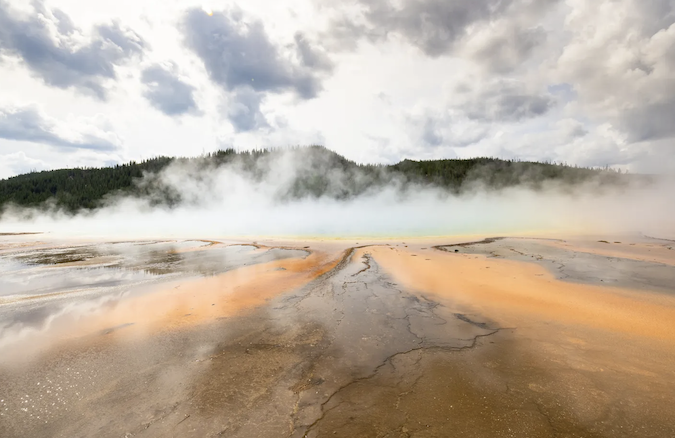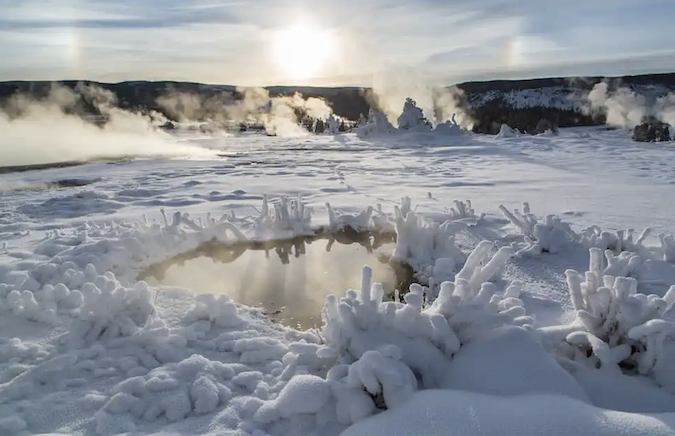More liquid magma fills the caldera below Yellowstone National Park than previously estimated, according to a new study, but there’s no cause for alarm. Yellowstone still isn’t likely to erupt in a catastrophic way in our or our children’s lifetimes. It’s not even likely to slowly ooze lava anytime soon.
Instead of foretelling an apocalypse, the new study gives a slightly clearer picture of what lies miles below the Earth’s crust. Michael Poland, scientist-in-charge of the Yellowstone Volcano Observatory, likens it to the Hubble Space Telescope. The lens on the telescope was blurry. Astronauts replaced that lens and suddenly everyone had a better view of space. A better view didn’t change space, it just let us see it more clearly.
It may seem strange for researchers to emphasize that a groundbreaking study published in a prestigious journal like Science doesn’t change the outcome of something as consequential as a volcano, but that’s the point. For a frequently overhyped system such as Yellowstone, researchers mostly want people to know that the risk is quite low, but the science is still quite interesting.
 Yellowstone National Park’s Grand Prismatic Spring, seen here from the boardwalk. (NPS/Jacob W. Frank)
Yellowstone National Park’s Grand Prismatic Spring, seen here from the boardwalk. (NPS/Jacob W. Frank)
The Yellowstone system has a long history of spectacular explosions. The current landscape was formed largely by three major events, the first about 2.1 million years ago, then 1.3 million years ago, then 631,000 years ago. Each of those eruptions was significant enough to blanket much of the western half of the U.S. in ash. More than 20 lava flows have pushed up from the ground and spread out over the landscape since the last explosion, the most recent being 70,000 years ago. That lengthy calm does not mean Yellowstone is primed to blow again.
It mostly means Yellowstone doesn’t do all that much all that often, Poland said, at least when it comes to volcanic activity.
The challenge with truly understanding what’s underneath Yellowstone or any other volcanic system is that we can’t see it. So researchers are left with assumptions and the best data they can gather. Fortunately, more data has been collected on Yellowstone than almost any other volcanic system in the world, which is where Ross Maguire, an assistant professor at the University of Illinois, comes in.
Maguire is the lead author on the new study published Dec. 1 in the journal Science called “Magma accumulation at depths of prior rhyolite storage beneath Yellowstone Caldera.”
Broken down in simple terms, he and his team used a supercomputer to analyze seismic waves that constantly weave through the earth’s crust. In some ways it’s like a CT scan on a human. Waves travel at one speed through solids and slow down when they hit liquids, allowing Maguire and others to get a better picture.
Previous studies estimated about 5% to 15% of the mass beneath Yellowstone was liquid magma. The new research shows it’s likely 16% to 20%. That increase doesn’t represent a significant change, but a more nuanced understanding.
Most importantly, the research continues to illustrate that what lies beneath Yellowstone is not some enormous tank or reservoir of liquid magma ready to burst through the surface. It’s not a ticking time bomb, said Kari Cooper, a professor at the University of California, Davis, and one of the world’s leading volcanologists who wrote a perspective piece to accompany the paper. Yellowstone’s magma chamber is really more of a great chamber of mush.
She likens it to a snow cone where the ice in the snow cone is rock and the liquid magma is the delicious sugary syrup mixed in. In some spots the ice is melted and the liquid pools. In most areas, it’s distributed evenly. Researchers can only guess what could cause that snow cone to eventually be melty enough to produce lava that rises to the surface. The physics of it, Cooper said, “is complicated.”
Regardless, anything that could produce that kind of reaction in a system as large as Yellowstone would be major.
“Communities in Gardner in West Yellowstone, Jackson and Cody, they would feel it, they would see it in the changes in the geyser activity and the gas emissions,” said Poland. “The ground would be rising. It would be pretty obvious.”
Why does a more accurate picture matter? Because the more we learn about volcanic systems, the more we understand their behavior and can interpret their signs, Cooper said. While each volcano certainly has its own personality — Hawaii’s currently erupting Mauna Loa, for example, has spewed 34 times since its first recorded eruption in 1843 — research like Maguire’s can also teach us more about volcanoes in general.

Rime ice and sun dogs create a winter scene in Yellowstone National Park’s Upper Geyser Basin in December 2015. (Neal Herbert/National Park Service)
“All these studies of what’s going on below the surface are important because they allow us to interpret the monitoring signals that we’re getting from the surface,” said Cooper. “In order to say — ‘OK, what does this seismic pattern, or earthquake pattern or deformation pattern mean?’ — you have to have an image in your head of what could be happening below the surface.”
For Maguire, it’s about increasing knowledge about the long-term evolution of our planet.
It also shows how far humans have come in our ability to use supercomputers to understand the Earth’s depths, which means we can continue to develop clearer pictures of what is there.
As far as risk goes, Poland has advice for anyone feeling nervous about the volcano.
Plenty of hazards exist in Yellowstone that have nothing to do with the caldera. The plates in the area are capable of earthquakes with a magnitude of 7 or greater. The hydrological system can produce geysers that spew mud and rocks and leave craters up to a mile wide. And none of the daily variation in geysers and earthquakes signal any real change in the volcano itself.
“I think that there’s a disservice done by the documentaries and the clickbait and the YouTube channels that focus on this thing that’s not going to happen, versus some of the things that could happen on human timescales like large earthquakes and steam explosions,” Poland said.
WyoFile is an independent nonprofit news organization focused on Wyoming people, places and policy.

1 comment
Thanks for sharing. I read many of your blog posts, cool, your blog is very good.